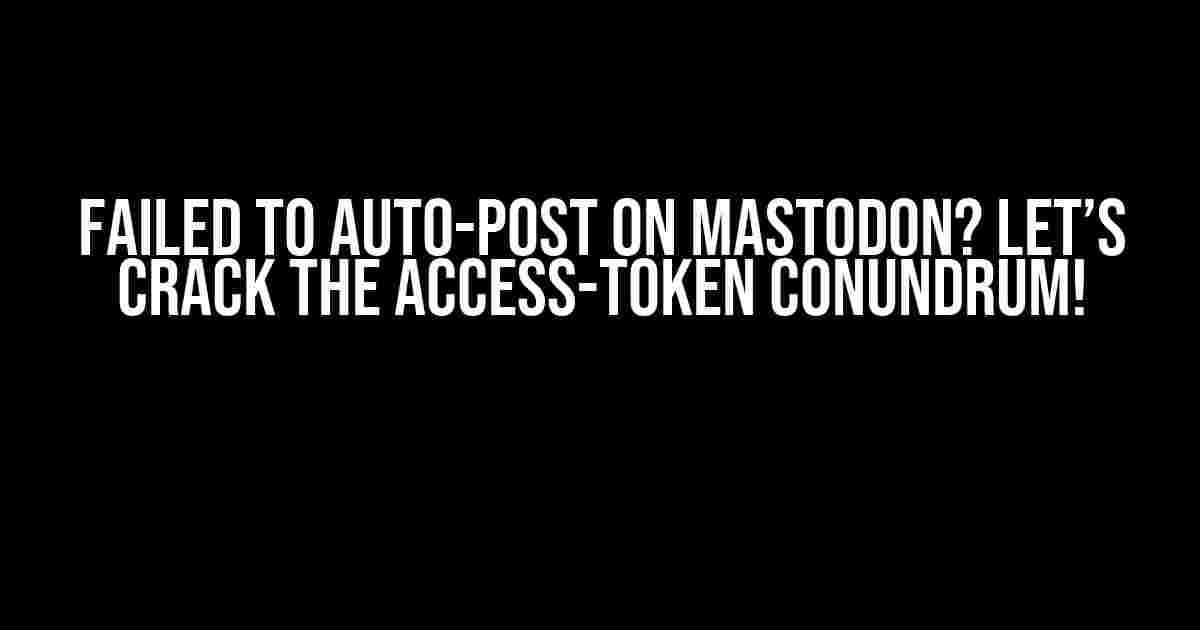Mastodon, the decentralized social network, offers a unique experience for users. However, when it comes to auto-posting, things can get a bit tricky. If you’re stuck with an “Unable to use Mastodon access-token for auto-posting” error, don’t worry, we’ve got you covered! This comprehensive guide will walk you through the process of troubleshooting and resolving the issue, ensuring you can seamlessly auto-post on Mastodon.
The Mystery of the Mastodon Access-Token
The Mastodon access-token is a crucial element in auto-posting. It acts as a digital key, granting your application or bot permission to interact with the Mastodon API on your behalf. Think of it as a special password that allows your auto-posting tool to access and manage your Mastodon account.
Common Issues with Mastodon Access-Tokens
Before diving into the solutions, let’s quickly examine some common issues that might lead to the “Unable to use Mastodon access-token for auto-posting” error:
- Incorrect or malformed token: A typo or incorrect formatting can render the access-token unusable.
- Token expiration: Mastodon access-tokens have a limited lifespan. If your token has expired, you’ll need to obtain a new one.
- API rate limiting: Excessive requests to the Mastodon API can result in rate limiting, making it impossible to use the access-token.
- Permission issues: Lack of necessary permissions or incorrect scope can prevent the access-token from functioning correctly.
Troubleshooting and Resolving the Issue
Now that we’ve covered the possible causes, let’s get down to business and troubleshoot the problem step-by-step:
Step 1: Verify the Access-Token Format
Double-check that your access-token is in the correct format. A valid Mastodon access-token should resemble this:
Bearer YOUR_ACCESS_TOKEN_HERE
Make sure to replace “YOUR_ACCESS_TOKEN_HERE” with your actual access-token.
Step 2: Check Token Expiration
Verify the expiration date of your access-token. You can do this by:
- Logging into your Mastodon account
- Navigate to the
Settings > Developer > Access Tokenspage - Locate the access-token in question and check the
Expires incolumn
If the token has expired, you’ll need to obtain a new one by following the same steps used to create the original token.
Step 3: Review API Rate Limiting
Ensure you’re not exceeding the Mastodon API rate limits. You can check the current rate limit status by sending a request to:
https://mastodon.example/api/v1/instance
Look for the ratelimit_limit and ratelimit_remaining values in the response. If you’ve reached the limit, wait for the rate limit to reset or adjust your auto-posting frequency.
Step 4: Verify Permissions and Scope
Confirm that your access-token has the necessary permissions and scope to perform auto-posting. You can check the token’s scope by examining the scope parameter during the token creation process or by decoding the token using a tool like jwt.io.
Best Practices for Mastodon Access-Tokens
To avoid future issues with your Mastodon access-token, follow these best practices:
| Best Practice | Description |
|---|---|
| Store tokens securely | Keep your access-tokens in a secure, encrypted environment to prevent unauthorized access. |
| Use unique tokens for each app | Generate separate access-tokens for each application or bot to maintain isolation and minimize the impact of a potential security breach. |
| Monitor token expiration | Regularly check the expiration dates of your access-tokens and obtain new ones when necessary. |
| Respect API rate limits | Avoid excessive requests to the Mastodon API by implementing rate limiting and caching mechanisms in your application. |
Conclusion
By following this comprehensive guide, you should be able to troubleshoot and resolve the “Unable to use Mastodon access-token for auto-posting” error. Remember to always handle access-tokens with care, respect the Mastodon API rate limits, and maintain up-to-date knowledge of the latest best practices.
Happy auto-posting on Mastodon!
Frequently Asked Question
Having trouble using your Mastodon access-token for auto-posting? Don’t worry, we’ve got you covered!
Why am I getting an error when trying to use my Mastodon access-token for auto-posting?
This might be due to an invalid or expired access-token. Try revoking and regenerating a new token, making sure to copy it correctly and without any whitespace characters. Also, double-check that you have the necessary permissions for auto-posting.
I’ve generated a new access-token, but it’s still not working. What’s going on?
Make sure you’re using the correct token for the right Mastodon instance. If you’re still having issues, try checking the token’s scope and permissions. Ensure that it has the necessary permissions for auto-posting and that the instance is correctly configured.
How do I know if my access-token is valid and has the necessary permissions?
You can check your token’s validity and permissions by using a tool like curl or a REST client. Make a GET request to the Mastodon instance’s API endpoint (e.g., https://mastodon.example/api/v1/accounts/verify_credentials) with the token in the Authorization header. If the token is valid, you should receive a successful response with your account information.
What’s the best way to handle access-token rotation for auto-posting?
It’s a good practice to rotate your access-token regularly to maintain security. You can set up a cron job or a scheduled task to revoke and regenerate a new token at regular intervals. Make sure to update your auto-posting tool or service with the new token to avoid any disruptions.
Are there any additional security measures I should take when using access-tokens for auto-posting?
Yes! Always handle access-tokens with care, as they grant access to your Mastodon account. Store them securely, avoid hardcoding them, and never share them publicly. Consider using environment variables, secure storage, or encryption to protect your tokens. Also, regularly review your token’s permissions and revoke any unused or unnecessary tokens.
